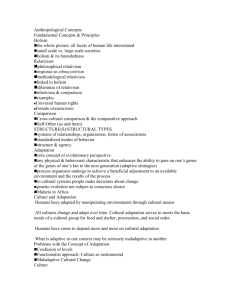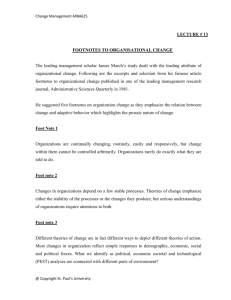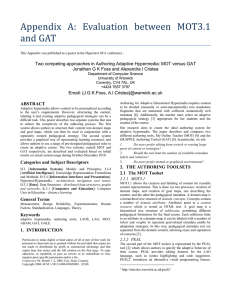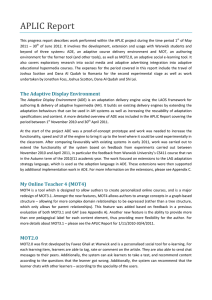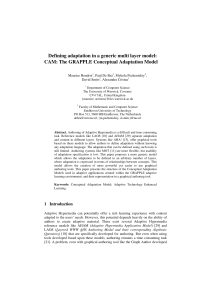Learntec
advertisement
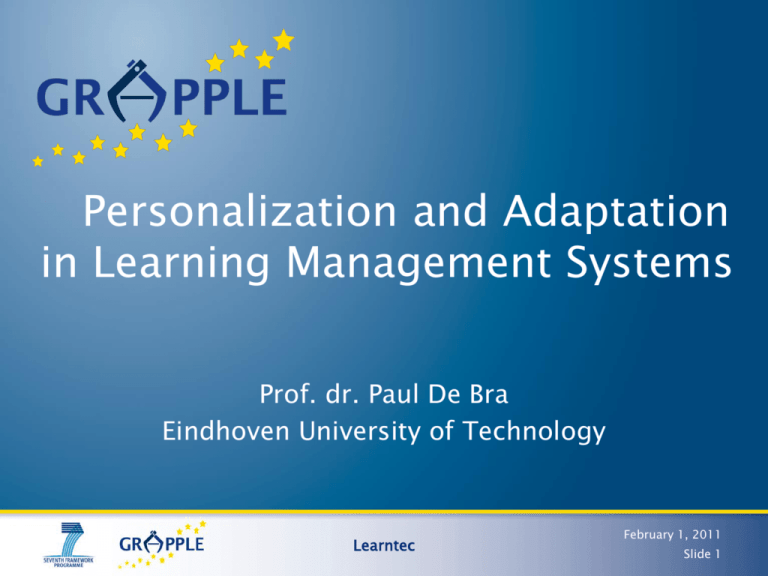
Personalization and Adaptation
in Learning Management Systems
Prof. dr. Paul De Bra
Eindhoven University of Technology
Learntec
February 1, 2011
Slide 1
What is GRAPPLE?
• EU FP7 STREP Project
– 15 partners from 9 countries
– 12 education/research, 3 companies
– budget 5.3 M€, subsidy 3.85 M€
– 3 year project, Feb. 2008 to Jan. 2011
– main goal: delivering an integration
between Learning Management Systems
and Adaptive Learning Environments
Learntec
February 1, 2011
Slide 2
GRAPPLE Consortium
user modeling
architectures
adaptive e-learning
TU/e
TUDelft
DFKI
L3S
authoring
metadata
interfaces /
server technology
Warwick
OUNL
TCD
VUB
interaction
ATOS
USI
UCL
standards
learning design
eXact learning sol.
UCAM
IMC
open source learning
UniGraz
management
evaluation
Learntec
industrial learning
technology
February 1, 2011
Slide 3
What is Adaptive TEL?
• Technology-Enhanced Learning
= learning with the help of ICT
(e-learning and blended learning)
• Adaptive means it involves
automatic personalization
– Knowing who the learner is is automatic
– Adapting to that learner is automatic
Learntec
February 1, 2011
Slide 4
LMS versus ALE
• A Learning Management System (LMS)
– supports the learning process;
– offers a personalized context;
– helps the teacher and institute more than
the learner.
• An Adaptive Learning Environment (ALE)
– supports the learning process;
– offers personalized content;
– helps the learner, not the institute.
Learntec
February 1, 2011
Slide 5
What do we adapt in GRAPPLE?
• “Traditional” adaptation in TEL is course
sequencing. We don’t want this!
• A course is a hypermedia application:
– navigation freedom through rich link structure
adaptive link annotation to provide guidance;
(based on prerequisites or learning style)
– pages (“nodes”) can be adapted to give
additional or alternative explanations (or
examples or illustrations)
Learntec
February 1, 2011
Slide 6
Adaptive System Functionality
event
user model
user model
adaptation
Learntec
February 1, 2011
Slide 7
Adaptation in GRAPPLE
• User Model is in any data format
– any event you can record can be used
– any computation can be done:
event + user model new user model
• Adaptation is any transformation you can
program
– any data format for the learning material
– adaptation based on all user model data
Learntec
February 1, 2011
Slide 8
Learntec
February 1, 2011
Slide 9
Learntec
February 1, 2011
Slide 10
Creating Adaptive Courses
• Creating conceptual adaptation models
– using authoring tools
– understanding prerequisites
• Creating content (pages) for GALE
– using templates and layout definitions
– user model operations within pages
• Setting up the GRAPPLE infrastructure
– combining an LMS with GALE
– exchanging user model information
Learntec
February 1, 2011
Slide 11
The GRAPPLE Course Model
• A course consists of concepts and relationships
• A concept has
– properties: value given by the author
– attributes: (generated by the authoring tool)
• value determined by adaptation rules;
• properties, includes data type, persistence, …
• event code: what to do when the value changes
– resources:
• URL to locate the file
• properties can be used to select between resources
– event code: (code on access, also generated)
Learntec
February 1, 2011
Slide 12
Learntec
February 1, 2011
Slide 13
Pedagogical Relationship Types
• PRTs define pedagogical relationships between
(sets of) concepts:
– can be directed or undirected (this is mainly a
visualization aspect)
– can have one or more sockets
– each socket is a placeholder for a set of
concepts
– a PRT has template adaptation rule code
– a PRT defines which user model attributes the
concepts in each socket must have
Learntec
February 1, 2011
Slide 14
Learntec
February 1, 2011
Slide 15
The GRAPPLE Adaptation Engine
• Concept access
1. user model updates (execute event code)
2. determine adaptive layout
3. retrieve and adapt a “page” (xml file)
•
•
conditional inclusion of fragments/objects
adapt destination+presentation of links
4. generate additional parts: header, footer,
accordion menu, …
Learntec
February 1, 2011
Slide 16
Learntec
February 1, 2011
Slide 17
Creating Content for GALE
• Content = nodes (pages) in XML
– standard HTML and XHTML can be used
– special “gale” tags for adaptation:
<if> <then> <else> for conditional inclusion
<object> for adaptive resource inclusion
<a> for adaptive link annotation
<variable> and <attr-variable> for inserting
user model data (in body or within a tag)
• <for> for repetitive insertion (through
relationships)
•
•
•
•
Learntec
February 1, 2011
Slide 18
Authoring Pages Separately
Learntec
February 1, 2011
Slide 19
Template-Based Authoring
Learntec
February 1, 2011
Slide 20
Conditional Inclusion of Fragments
• Example from the course “hypermedia
structures and systems” taught at the TU/e:
– Before reading about Xanadu the URL page shows:
…
In Xanadu (a fully distributed hypertext system, developed
by Ted Nelson at Brown University, from 1965 on) there
was only one protocol, so that part could be missing.
…
– After reading about Xanadu this becomes:
…
In Xanadu there was only one protocol, so that part could
be missing.
…
Learntec
February 1, 2011
Slide 21
Link Adaptation in GALE
• Standard schema:
– links are good, neutral or bad;
– link classes are used by a CSS stylesheet to create
the presentation color scheme
• Actual functionality:
– any expression to define the link classes
(${#suitability}?(${#visited}>0?\"neutral\":\"good\"):\"bad\")
– any expression to choose the stylesheet
– any expression to choose icons
Learntec
February 1, 2011
Slide 22
Life-long Learning in GRAPPLE
• Learners move during their life time:
different companies and institutes
– Learner information (user model) must be
stored independently of the LMS+ALE
– Different LMSs and ALEs must be able to
communicate with each other
– Learners should have a single identity
everywhere
Learntec
February 1, 2011
Slide 23
Learntec
February 1, 2011
Slide 24
Learntec
February 1, 2011
Slide 25




